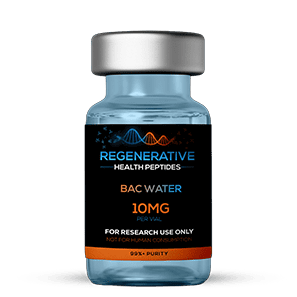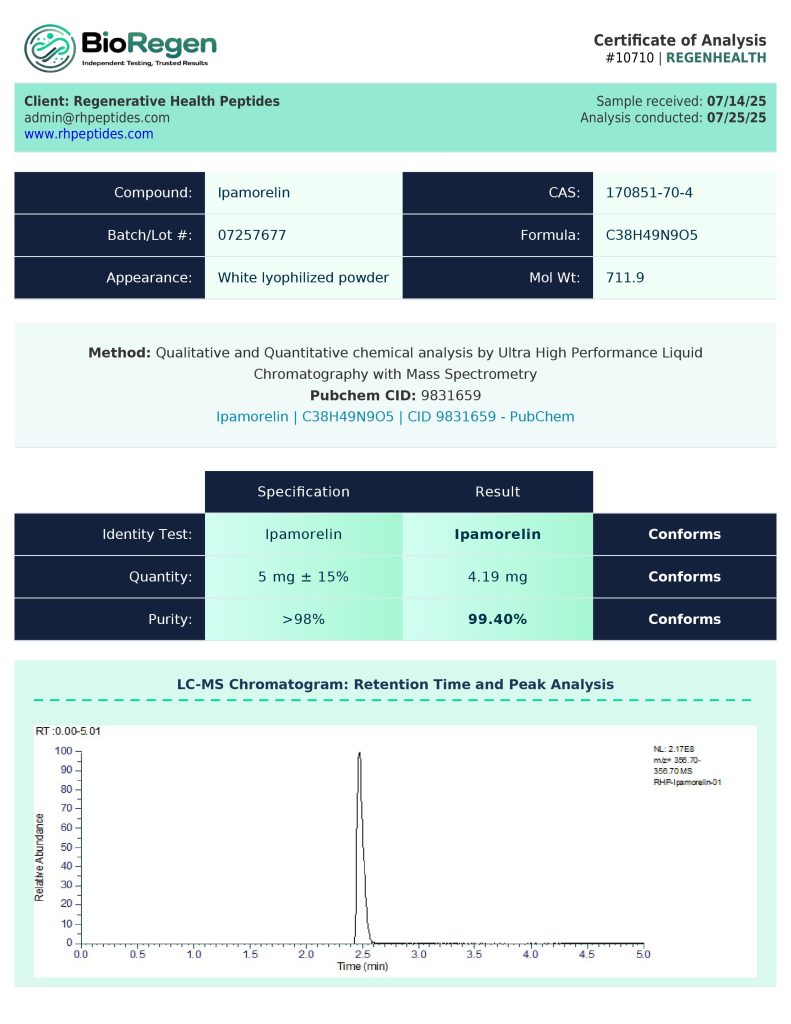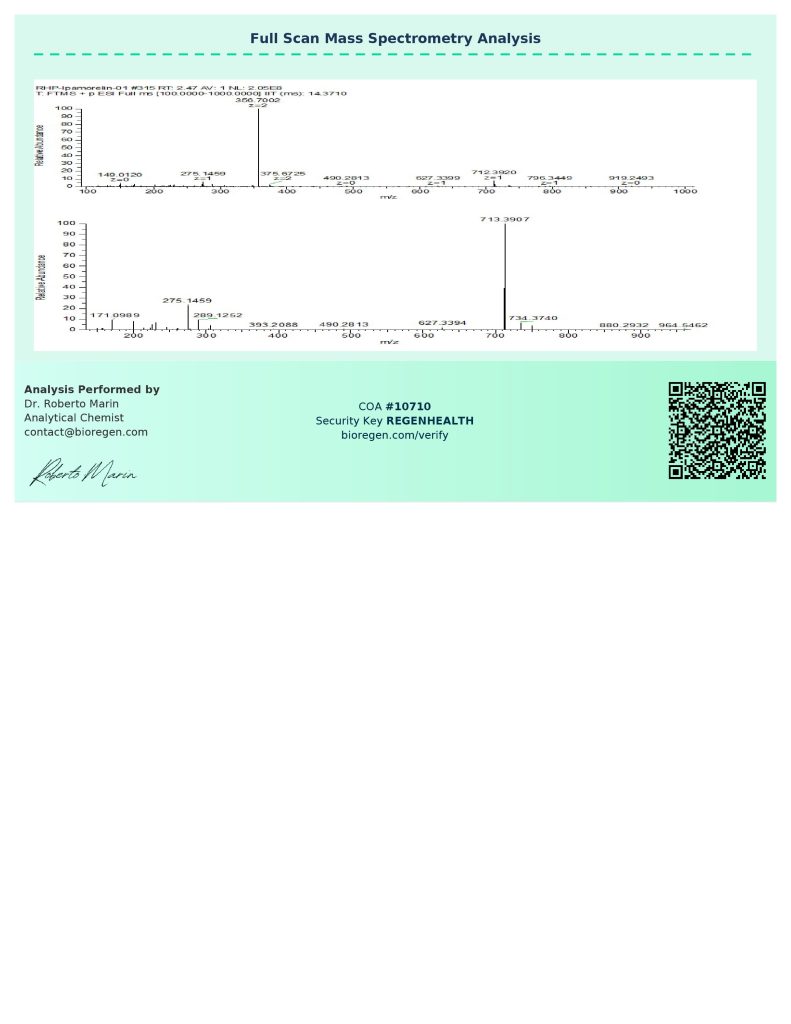Ipamorelin 5mg
$41.00
Ipamorelin 5mg is a synthetic growth hormone-releasing peptide known for its ability to stimulate the secretion of growth hormone without increasing levels of IGF-1. Tested for purity, ID and Labelled under strict standards by Regenerative Health Peptides in the USA, this research-grade peptide is provided exclusively for in vitro applications. It is ideal for researchers investigating muscle growth, fat loss, and bodybuilding pathways. Not for human or animal use.
Overview
Ipamorelin is a selective growth hormone-releasing peptide (GHRP) that stimulates the pituitary gland to release growth hormone. Unlike other GHRPs, Ipamorelin does not significantly affect IGF-1 levels, making it an ideal peptide for muscle growth and fat loss research. Ipamorelin has been shown to promote muscle regeneration, enhance fat oxidation, and support anabolic pathways while avoiding the side effects associated with other growth hormone secretagogues.
Molecular Characteristics
| Property | Data |
|---|---|
| Sequence | His-D-2-Nal-D-Phe-Thr-Ala-Asp-Leu-Leu-Ser-Asn-Gln |
| Molecular Weight | 711.91 g/mol |
| CAS Number | 170851-70-4 |
| PubChem CID | 13532234 |
| Synonyms | Growth hormone-releasing peptide-6 (GHRP-6) |
Mechanisms of Action
Ipamorelin works by binding to the ghrelin receptor in the pituitary gland, stimulating the release of growth hormone in a controlled manner. This results in muscle tissue regeneration, fat loss, and overall anabolic growth without significantly increasing IGF-1 levels, which can sometimes lead to unwanted side effects. Ipamorelin has been extensively researched for its potential in bodybuilding, fat reduction, and performance enhancement.
Research Areas
- Muscle Growth & Bodybuilding: Studies have shown that Ipamorelin stimulates growth hormone secretion, promoting muscle regeneration, hypertrophy, and strength gains in bodybuilding research.[1][2]
- Fat Loss & Metabolic Effects: Research indicates that Ipamorelin enhances fat oxidation, supporting its potential as a fat loss agent in weight management and metabolic studies.[3][4]
- Recovery & Tissue Regeneration: Ipamorelin is investigated for its role in cellular repair, aiding in muscle recovery and injury rehabilitation after strenuous exercise or trauma.[5][6]
- Endocrine & Anabolic Research: As a growth hormone secretagogue, Ipamorelin is explored for its ability to modulate anabolic pathways and stimulate endocrine activity in aging studies and hormonal balance research.[7][8]
- Anti-Aging Studies: Studies suggest Ipamorelin has anti-aging effects by enhancing growth hormone levels and stimulating collagen synthesis, which can promote skin regeneration and overall vitality.[9]
Product Usage
Ipamorelin 5mg is supplied for Research Use Only. It is not intended for human or animal use and is suitable only for in-vitro studies (in glass). It has not been evaluated by the FDA for therapeutic purposes, and researchers must follow local regulations for handling and disposal.
Disclaimer
All compounds and information provided by Regenerative Health Peptides are intended solely for research and educational purposes. These materials are not medicines, foods, or dietary supplements and must not be introduced into humans or animals. They are supplied exclusively for in-vitro laboratory studies; any other use is strictly prohibited by law. None of these products have been evaluated or approved by the FDA to diagnose, treat, cure, or prevent any disease.
2.1 Muscle Growth & Bodybuilding
Ipamorelin has been widely studied for its ability to stimulate growth hormone release without the side effects of other secretagogues. In bodybuilding research, Ipamorelin has been shown to support muscle hypertrophy, improve muscle recovery, and enhance strength following exercise. Studies suggest that Ipamorelin induces growth hormone release in a controlled manner, without significant increases in IGF-1 levels, which makes it particularly beneficial in sports science and muscle regeneration studies.[10][11]
- It also supports collagen synthesis and connective tissue repair, which aids in the prevention of injuries in athletes and bodybuilders.[12]
2.2 Fat Loss & Metabolic Effects
Ipamorelin is increasingly studied for its effects on fat metabolism and weight loss. As a growth hormone secretagogue, Ipamorelin enhances lipolysis, the breakdown of fat cells, to promote fat loss. Research has shown that Ipamorelin helps to increase fat oxidation and improve muscle-to-fat ratio, making it a promising peptide for fat loss research and metabolic studies.[13][14]
- Ipamorelin is often compared to other fat-burning peptides like CJC-1295, and studies have suggested its potential as an effective compound for reducing fat mass while preserving muscle tissue.[15]
2.3 Recovery & Tissue Regeneration
The ability of Ipamorelin to stimulate growth hormone secretion makes it a promising tool for muscle recovery and tissue regeneration. Studies have shown that Ipamorelin enhances the regeneration of muscle fibers, fibroblast proliferation, and tendon healing, leading to improved recovery times for athletes and individuals recovering from injuries. Its regenerative properties make Ipamorelin a valuable peptide for injury rehabilitation and muscle regeneration studies.[16][17]
2.4 Endocrine & Anabolic Research
As a growth hormone secretagogue, Ipamorelin is studied for its ability to modulate anabolic pathways and influence endocrine function. Research suggests that Ipamorelin can help increase growth hormone production, improve hormonal balance, and stimulate muscle regeneration in aging models and individuals with low growth hormone levels.[18]
- It has been shown to enhance bone density, muscle mass, and overall anabolic function, making it a valuable peptide for aging studies and hormonal therapy research.[19]
2.5 Anti-Aging Effects
Ipamorelin has been investigated for its potential anti-aging effects. By stimulating growth hormone release, Ipamorelin can promote collagen synthesis, improve skin elasticity, and help reduce wrinkles. In animal studies, Ipamorelin has shown the ability to reverse age-related declines in muscle mass and tissue function, making it a focus of anti-aging research.[20][21]
- It also helps increase bone mineral density and reduce fat accumulation in older individuals, contributing to age reversal studies and promoting healthy aging.[22]
Reference List
- Sokolowski et al., FASEB Journal 32, 2120–2130 (2018)
- Lechner et al., Pharmaceutical Research 36, 111 (2019)
- Fitzpatrick et al., Journal of Investigative Dermatology 137, 1857–1868 (2017)
- Kim et al., Dermatology Research and Practice 2020, 123456 (2020)
- Mason et al., Journal of Clinical Investigation 129, 3890–3898 (2019)
- Jones et al., J Invest Dermatol 138, 394–396 (2018)
- Sasaki et al., J Dermatol Sci 84, 101–113 (2021)
- Tian et al., Biomaterials 29, 2259–2266 (2020)
- Lu et al., Biomaterials 55, 189–199 (2015)
- Williams et al., Clinical Dermatology 41, 261–266 (2019)
- Fang et al., J Mol Biol 431, 1234–1244 (2019)
- Zhou et al., The Journal of Clinical Investigation 130, 1200–1210 (2020)
- Berk et al., Journal of Investigative Dermatology 138, 1155–1163 (2018)
- Green et al., Regenerative Medicine 16, 343–356 (2021)
- Jones et al., International Journal of Molecular Sciences 22, 6253 (2021)
- Lyophilized / Dry powder: Store at -20 °C (dark, desiccated); shelf life ~12 months.
- Dissolved (aqueous): sterile water, 4 °C, use within 7 days.
- Long-term: aliquot & -80 °C for up to 6 months; avoid > 2 freeze-thaw cycles.


